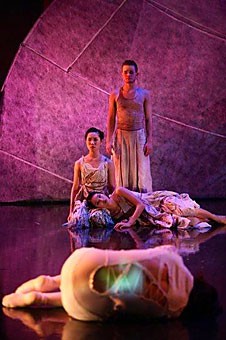Never has there been a performance that will appeal to so many groups of people.
Visiting artists Alison Rootberg and Margaret Schedel of KinestheTech Sense will give a performance today that mixes dance and music with the latest in computer technology. Their performance of FleshLightMovement is sure to intrigue dancers, musicians, filmmakers and computer programmers equally.
In FleshLightMovement Rootberg and Schedel explore the relationships between movement, music and video. As Rootberg dances, her shadow will be projected onto a screen. Schedel will meanwhile be playing the cello in response to the movements of the dancer.
This is not all, though. A second screen will be on stage, on which a version of the dancer’s shadow is manipulated by the music being played. Through complex computer software, the signals from the cello will be recorded and translated into signals for the video. For example, at certain pitches, the cello might cause the video of the dancers shadow to pause, or repeat previous motions, or run backwards.
The performances of KinestheTech Sense are often interactive, with the cellist able to manipulate the video and motions of the dancer, and the dancer’s moves affecting the music played. The cyclical nature of this process means that each artist strengthens and plays off of the other, making it impossible to separate music from dance.
“”This idea of interactivity is not new, said Craig Walsh, a UA professor who teaches electro-acoustic composition. Walsh, an expert in this field of music, eagerly talked about the evolution of electronic music.
“”It started in the 1940s with tape music,””he said. “”Mainly train and water sounds. The ’50s had taped concerts, but it was boring for people to
The goal is to make the computer not more human but more involved in the creative process
Craig Walsh, UA professor
go to a concert and just look at speakers, so in the ’60s they brought performers onstage with the recordings.””
Electro-acoustic music today can be anything from playing music on your laptop, to a DJ, to more obscure things like KinestheTech Sense,”” Walsh said.
He divided electro-acoustic music into that which uses ambient sounds and the live electronic music popular today. Walsh spoke of an earlier KinestheTech Sense concert he had seen, in which the sounds they recorded and used were bells and trainlike.
The success of the electro-acoustic music is largely a result of technology and software. A program called Max/MSP allows different instruments and devices to communicate with one another and gives the artists the ability to morph sounds, recordings and replaying melodies. The software can even attempt to make music complimentary to that played by the artist.
“”The goal is to make the computer not more human but more involved in the creative process,”” Walsh said.
At today’s 2 p.m. performance in Crowder Hall, the audience will be given an opportunity to get up on stage and experiment with the technology. Rootberg and Schedel will also speak about the inspiration behind and processes involved in their performance.
Any budding electro-acoustic musicians, or anyone with an interest in dance, music, video or cool gadgets, should make sure to see FleshLightMovement. Admission is free.









